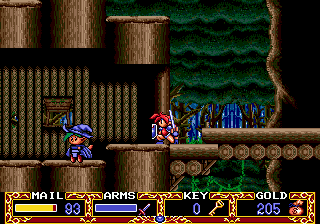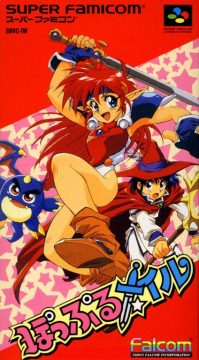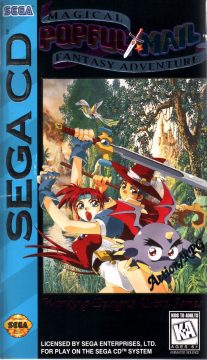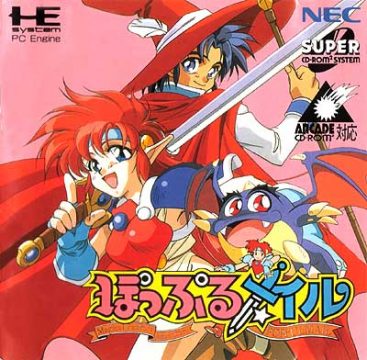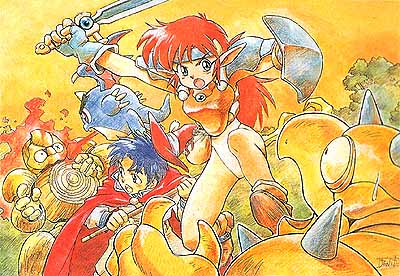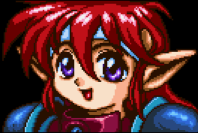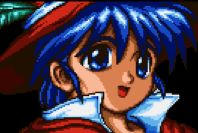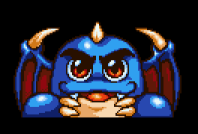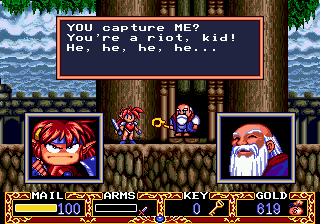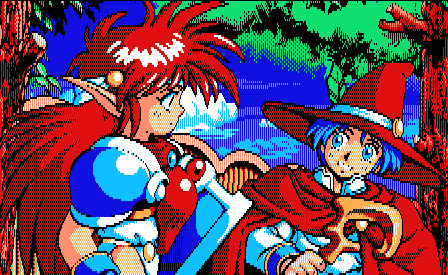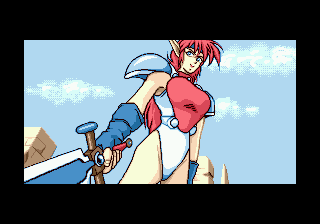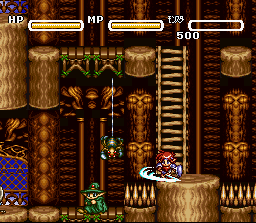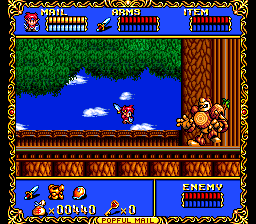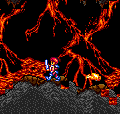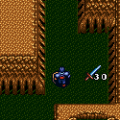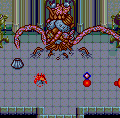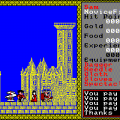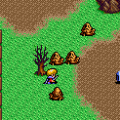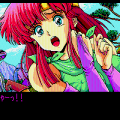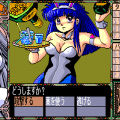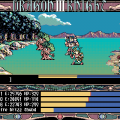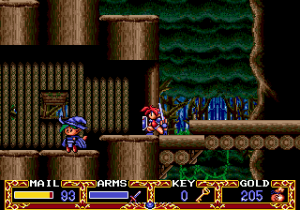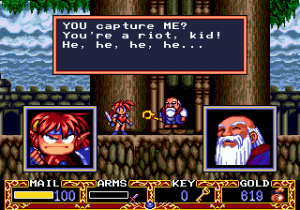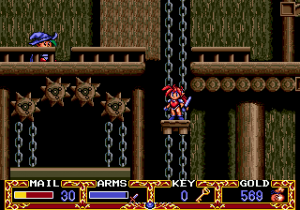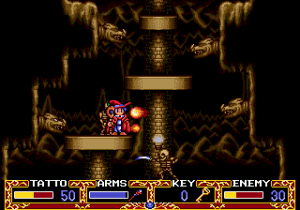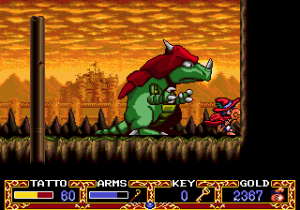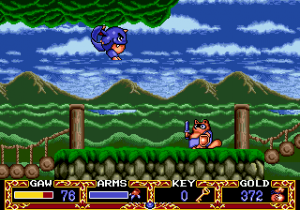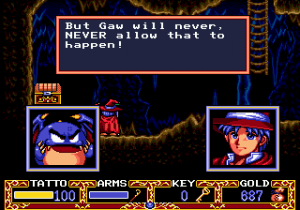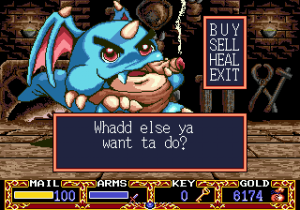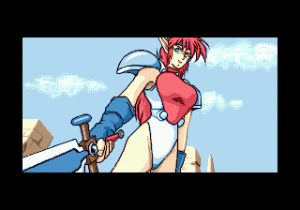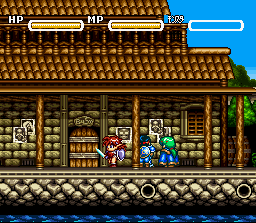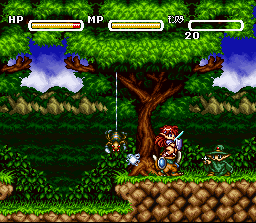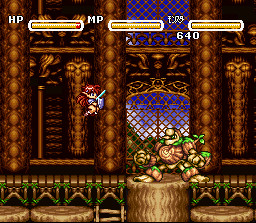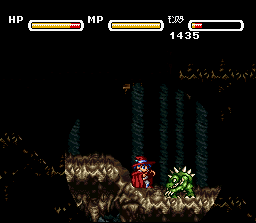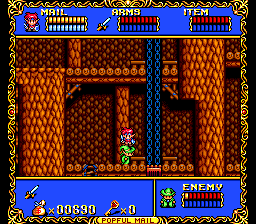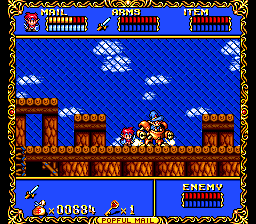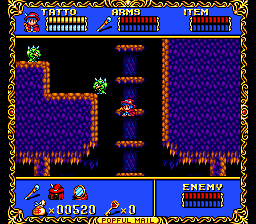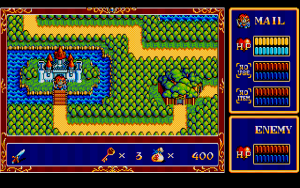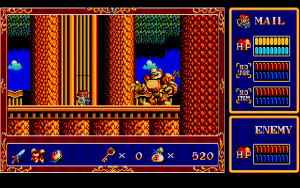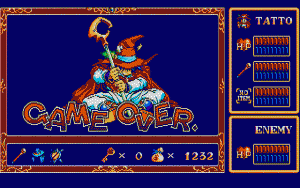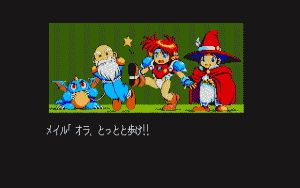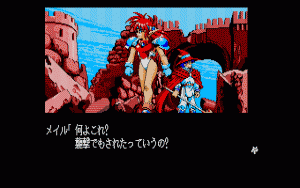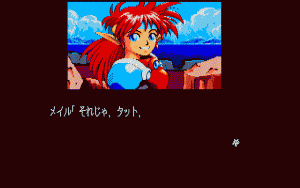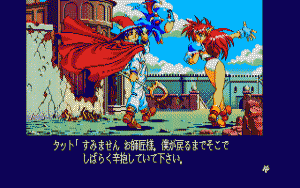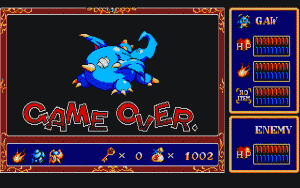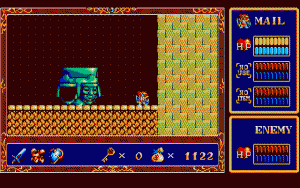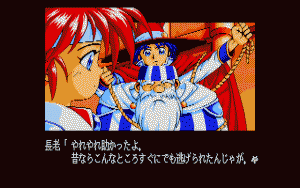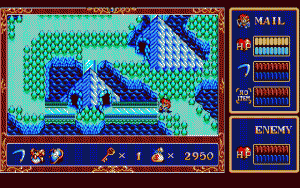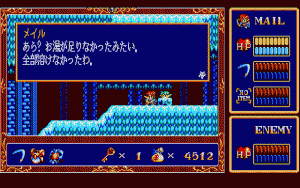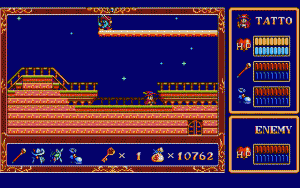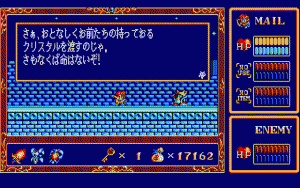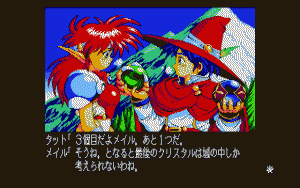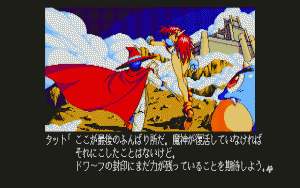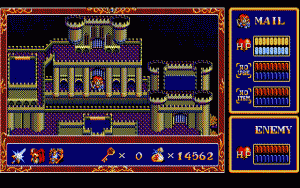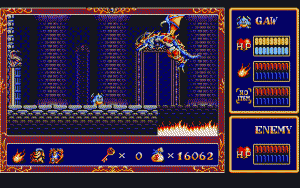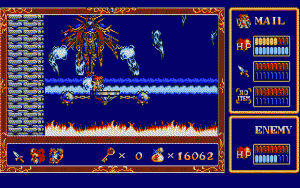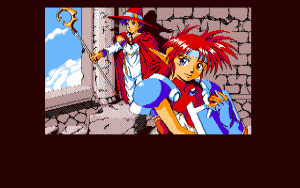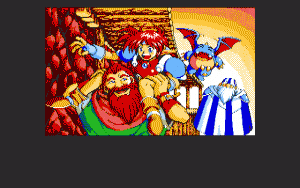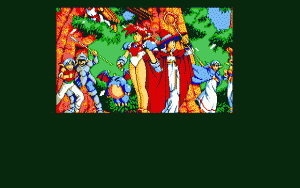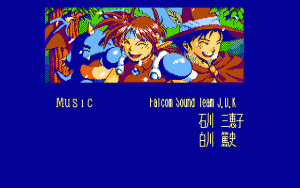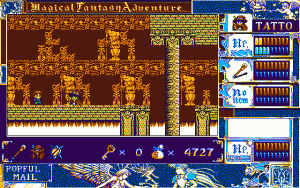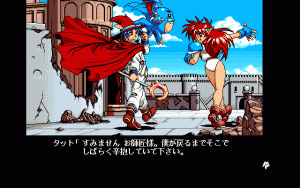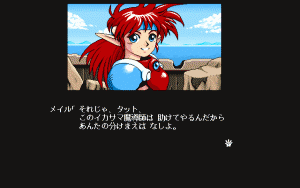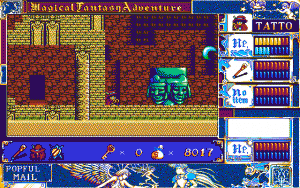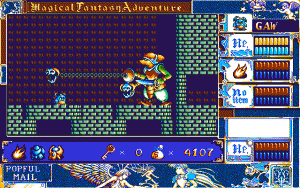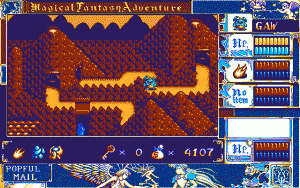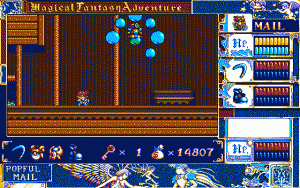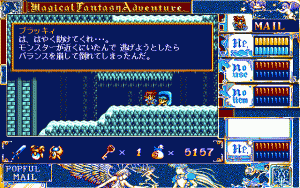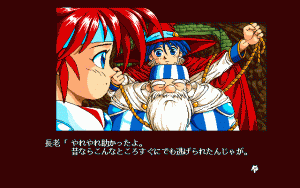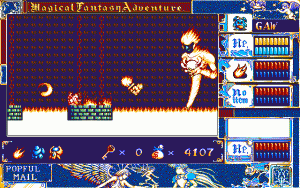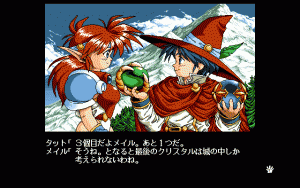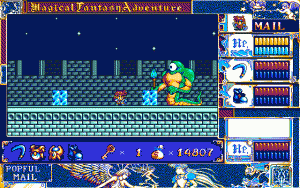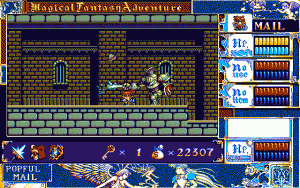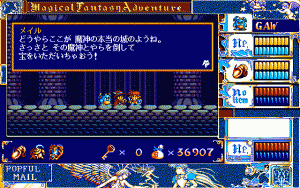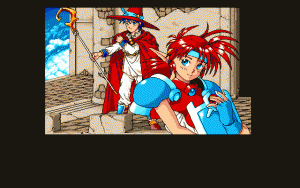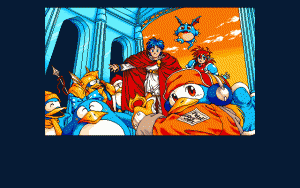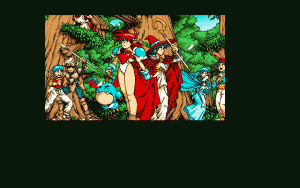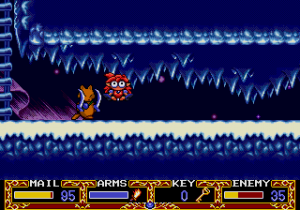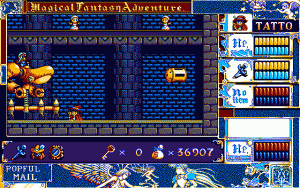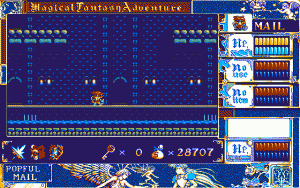Created by Falcom, publisher of popular Japanese RPGs such as Ys, Popful Mail is a fun little side scrolling action-RPG with anime style graphics and loads of personality. Directed by Yoshio Kiya, creator of the Dragon Slayer series as well as the Brandish games, it stars a pink haired elven bounty hunter named Mail. Her wacky adventures heavily resembles that of Lina Inverse in Slayers, which at this point in time in late 1991 was a fairly popular light novel series, before hitting worldwide recognition with the later anime series. The Japanese title is technically “Poppuru Mail”, which was changed to the slightly easier to pronounce “Popful Mail” for English release, which still isn’t exactly a word, but is meant to emphasize her bubbly personality.
Characters
A cute elven bounty hunter who is, unfortunately, terrible at her job. She refuses to stoop to taking menial jobs and instead sets her eyes on big prizes. The end result is usually failure. Still, Mail is determined, has a sharp demeanor, and enough sword skills to keep her alive.
Tatto
A somewhat naive magician who is searching for his missing teacher, Muttonhead. As it turns out, Muttonhead has gone off the deep end and is now working for the forces of darkness, so Tatto tries to help out Mail to set things right. Although he seems overly polite and is really just an apprentice, he’s pretty good at attacking from a distance with magic. Also, he wears a goofily large hat.
The game begins with Mail attempting to apprehend the mechanical villain Nuts Cracker. After failing miserably, she decides to hunt down the bounty on a renegade magician named Muttonhead (Material in Japanese). Along the way, she meets Tatto and Gaw, and stumbles upon the usual fantasy RPG plot of bad guys resurrecting old demons to create chaos across the realm. This being primarily an action game, the plot isn’t a terribly important aspect, so the charming characters make a good counterpart to the usual dark melodrama. The stages are the typical areas too, consisting of jungles, caves, mines, and volcanoes, plus an wintery landscape filled with penguins. The enemies are cute too, particularly the little sword-wielding raccoons in the jungle area.
Although the game begins with only Mail, Tatto and Gaw join within the first two worlds. You can switch between them at anytime, and each has their own separate life meter. However, when one of them dies, it’s Game Over, so you have to be careful.
While there aren’t any experience levels, you do spend a lot of time killing enemies to get gold, thus buying weapons, armor and curative items. There are five worlds total, each divided into several substages. While the game starts off linear, later areas require at least a little more of exploration and backtracking to find stuff. You can even revisit old levels on the world map, to gather anything you may have missed the first time, or use new skills to find previously inaccessible areas.
There are technically four versions of Popful Mail: the PC88/98 original, and then ports to the PC Engine CD, Super Famicom and Sega CD, all released a few years later. While they all use the same concept, plot, and structure, most of these are very different.
Popful Mail first hit the scene in 1991 for both the PC 88 and PC98 home computers. These are mostly the same, though the PC98 version runs at a higher resolution with more color depth (640×200 with 8 colors for the PC88, 640×400 with 16 colors for the PC98). This makes the biggest difference in the cutscenes. Even the PC88 version has parallax scrolling, though, which was one of the technical selling points of this and other Falcom games at the time.
Visually the PC versions resemble Xanadu and Legacy of the Wizard, two previous Falcom games directed by Kiya. The characters are short and squat, with a large portion of the screen devoted to the interface. Attacking is done by running into bad guys (similar to the bump system in the early Ys games), although you sometimes have to jump on them. Eventually, you get throwing weapons, magic spells, and other projectiles, which makes things a little easier, but the platforming feels a little awkward with such tiny characters. While the graphics are tiny, they’re quite vibrant and generally pretty attractive, while the cutscenes are outstanding. The FM synth soundtrack is excellent too.
The Sega CD version was developed by Sims and produced as part of the Sega-Falcom partnership that brought Mega Drive ports of Sorcerian, Legend of Heroes, and Lord Monarch. It’s the most recognized version since it’s the only one released in English, brought to the US courtesy of Working Designs in 1994. The game has been completely remade for something more suitable to a 16-bit console audience. It looks and plays like a regular action-platformer from the time, pretty similar to Sega’s Wonder Boy series, with larger characters, a smaller interface, and actual melee attacks rather than the bump system. Parts of the plot have been streamlined so there’s less annoying backtracking, and everything is much better for it. The graphics aren’t as bright and the character designs in the cutscenes are lot different, as everyone looks older and less cutesy than the original versions. Still, the animation in these scenes is spectacularly good, especially considering that it isn’t full motion video.
The music is all chip generated so there’s no redbook audio, but it sounds damn fine for the Sega CD sound synth, and in many ways better than the PC Engine version. There’s also a whole lot of speech, all of it very well done, in typical Working Designs style. (The Japanese version features Megumi Hayashibara as Mail, who also voiced Lina Inverse in Slayers, hammering home the resemblance between the characters.) While a lot of people don’t care for their loose interpretations of the original Japanese version, much of the dialogue and extra gags that they added really fit the game. In a part where you come across two soldiers, whom were just regular boring characters in the Japanese version, here they talk like the main cops from the TV show Dragnet. At one point, a recurring character named Slick (wisely renamed from Blackie in the original Japanese) makes a subtle reference to Melrose Place, a popular soap opera from the early 90s.
Unfortunately, like with many of their games, Working Designs toyed with the difficulty level for the American version, making it significantly harder. Items are more expensive, enemies inflict more damage (and your characters inflict less), Three hits from a bad guy will usually send your character down for the count, and your invincibility time after being hurt is already almost nil, making it fairly easy to get destroyed quickly. You can purchase an almost unlimited amount of healing items to counterbalance this, but due to the higher item cost you end up grinding more to combat this. It doesn’t completely ruin the game the way it messed up Exile: Wicked Phenomenon or Silhouette Mirage, but it does make it more aggravating, especially since the original game wasn’t meant to be all that hard. Like with many of these tweaks, there is a fanmade patch to change everything back to how it should be. A few extra additions are nice though, like a new title screen theme and different (and generally better) music in the cutscenes, plus cutesy little voiced bits from the characters on the Game Over screen.
The Sega CD version was originally conceived as a project called “Sister Sonic”, which would’ve replaced the main character (and probably everyone else) with an anthropomorphic character related to Sonic the Hedgehog. Due to substantial fan outcry, eventually Sega just decided to keep the characters (which was for the best, because nothing in this game would fit into the Sonic universe other than the slightly comical theme). No artwork was ever revealed of this project, so it’s unclear how far it came along before it changed back into Popful Mail.
Popful Mail was also ported to the Super Famicom by Falcom themselves, released shortly after the Mega CD version. Much like Sega’s version, it’s been redone as a more typical side-scrolling action-RPG, though the game itself is completely different. The graphics and stages have been entirely redone, and while the basic plot remains intact, there are some substantial changes in many of the areas you visit. Right off the bat, you can actually visit the first town, as all of the other versions, it only appeared in cutscenes. The map screen is gone too. There’s also a new character named Maril, who’s the granddaughter of Muttonhead.
However, the action is unrefined and is slightly awkward – the camera doesn’t give you a good enough view, and enemies don’t recoil when you hit them, so you have to be extra careful when fighting them. The moveset is a lot more versatile, though, as Mail gets a downward jumping slash and you can throw projectiles in any direction.
While it’s a good game, the limitations of the cartridge format definitely show through. You can only save the game at inns, which are often scarce. And when you die, you’re sent back to a checkpoint, usually making boss battles more tedious. The bosses themselves are pretty cruddy – you fought some pretty mean creatures that took up half the screen in the Sega CD version, and these have been noticeably downsized. Similarly, a lot of the goofy fun that came from the cutscenes is gone entirely. The music works reasonably well, at least, if not quite up to the levels of the other ports. Some tracks are re-used and rearranged, but there are plenty of exclusive tracks too. Overall, this is probably the weakest of the 16-bit ports, even if it is the only one officially done by Falcom.
The last port to be released is for the PC Engine Super CD, ported by a company called Hunex and published by NEC. Compared to the drastic changes of the other ports, this one stays pretty close to the original PC version. The resolution isn’t as a high as the PC98 game, but it does have a higher color palette, so while the cutscenes aren’t quite as detailed, in general it looks better, especially with the cut-ins during in-game dialogue sequences. The music is all CD audio, with different arrangements than the Sega CD version, since they were by completely different musicians. The cutscenes and major dialogue scenes are voiced, though the voice actors are different than the Mega CD version (and not as famous either, suggesting this was a lower budget effort). The core game is basically the same as the PC version, though it also adds a set of stages exclusive to the PC Engine port, where each of the characters splits up to fight their way through factories and ship graveyards. This version also supports the Arcade card for faster loading, though it works just fine with the regular Super card.
A mobile phone port was also developed for Japanese phones by Bothtec, which most closely resembles the PC version. As with most of these types of mobile games, it was distributed in pieces due to file size constraints.
Even with all the entirely different versions of Popful Mail, the Sega CD one is definitely the best, so if you only stick with that you won’t be missing out. The series was popular enough to inspire several radio dramas, although despite the potential, it never received an anime series. Unlike many other Falcom titles, it’s never seen any remakes either. Regardless, it’s a fun little action game with some incredibly amusing moments, and well worth investing in.
